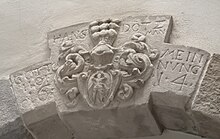

Burgher arms or bourgeois arms are coats of arms borne by persons of the burgher social class of Europe since the Middle Ages (usually called bourgeois in English). By definition, however, the term is alien to British heraldry, which follows other rules.
In some European countries, certain armorial bearings have traditionally been restricted to a particular social class (usually the nobility), e.g. the use of supporters in Great Britain, tinctures in Portugal or coronets in Sweden. Notwithstanding, in most countries outside the United Kingdom, any individual, family and community has usually been free to adopt arms and use them as they please, provided they refrain from wrongfully assuming the preexisting arms of another.[1] In addition to the bourgeoisie, peasants sometimes made use of this tradition.[citation needed] Arms of the clergy are classified as ecclesiastical heraldry.
Use of coats of arms by burghers and artisans began during the 13th century and in the 14th century some peasants took to using arms.[2] The arms of burghers bore a far wider variety of charges than the arms of nobility like everyday objects, and particularly tools. House marks are another type charges usually only used in burgher arms. Most widespread burgher heraldry was and still is found in Belgium, Germany, Switzerland and in the Netherlands. In the latter only a small percentage of the existing arms belong to the nobility.[3]
Crest-coronets in burgher arms are correct only if the arms were granted by a sovereign and the coronet is explicitly mentioned in the grant.[4]
- ^ Pastoureau, Michel (1997). Heraldry: Its Origins and Meaning. 'New Horizons' series. Translated by Garvie, Francisca. London: Thames & Hudson. p. 14. ISBN 0-500-30074-7.
- ^ Carl-Alexander von Volborth. Heraldry: Customs, Rules, and Styles. (Blandford Press, Dorset: 1981), p. 96
- ^ Carl-Alexander von Volborth. Heraldry: Customs, Rules, and Styles. (Blandford Press, Dorset: 1981), p. 106
- ^ Carl-Alexander von Volborth. The Art of Heraldry. Tiger Books International, London. 1991, p. 59 ISBN 1-85501-154-9
© MMXXIII Rich X Search. We shall prevail. All rights reserved. Rich X Search
